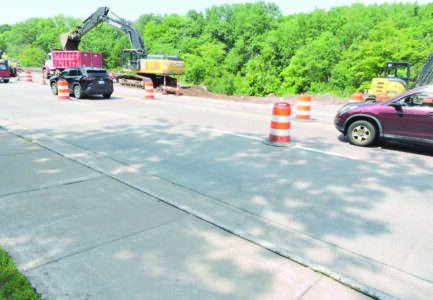DNR discusses moose, wolf population changes
ONTONAGON — The Western Upper Peninsula Citizens Advisory Council met Thursday evening at the Lake Superior Sportsman’s Club in Ontonagon. At the meeting, the council heard a presentation via Zoom from Michigan DNR’s Northern Michigan Wildlife Research Specialist Tyler Petroelje regarding a moose study and the wolf abundance trail camera survey.
The moose study is a collaborative project between the DNR, Keweenaw Bay Indian Community and Northern Michigan University. It was conducted after an observed stagnation of the moose population in the U.P. Petroelje said the population within the core range in Baraga, Marquette, and Iron counties has been at between 400 and 500 animals for the last decade. It was expected these ranges could support 1,000 moose, but that number has not materialized.
The project began in February with the GPS collaring of 20 moose to track their locations. Forty more moose are planned to be collared next February. The moose were collared with the primary goal to observe calf production, and 10 of the 20 collared moose were adult cows (female moose). Samples were collected from the 10 cows to test for pregnancy, and eight of them were positive. Petroelje told the council this sample is too small to draw conclusions on the moose population’s pregnancy rate.
The moose were able to be observed with drones flying to the locations the collars relayed. Five of the pregnant moose gave birth to single calves, while the other three birthed twins. One of the cows traveled over 50 miles from a core range to give birth in the Keweenaw Peninsula. Petroelje said the drones have been very helpful in the observation of the calves, which occur each month to check in on the calve’s survival.
“When you go into an area, there is a high risk of abandonment if you try to approach a cow and her calves,” Petroelje said, “especially if you’re going to try to think about handling and so these drones are offering us a much better way to monitor one: calf production, and then two: we can go in from monthly survival flights and see how many of these calves make it from month to month throughout their first few months of life, which are really the most risk prone times for calves in their first year of life.”
The movement of the animals is monitored, and when a disruption in usual movement occurs, the drones are sent out to observe, and this can sometimes reveal a mortality. When a moose is discovered to be deceased, samples are taken and wounds studied to determine what happened to the moose. The first calf mortality was due to black bear predation, another due to head trauma and another died to a wolf. The wolf predation was confirmed due to a collared wolf covering the same territory the moose was around. A cow was killed in a vehicle collision in mid June.
“The challenge with this one is that this was one of those cows that did have two calves with her,” Petroelje said. “So, those calves were abandoned. We did not find those calves at the scene, so we are unsure exactly what happened to them, but given their age, they cannot survive without the cow. So it’s very likely that those calves ended up being mortalities, and they were censored from our survival monitoring due to that vehicle collision.”
The report of the killed cow brought Petroelje to share 47 uncollated moose have been killed in the last three years in the U.P. The two months which seem to the the highest for moose-vehicle mortalities are June and September. More bulls (male moose) are killed in September, while June has equal sex fatalities. Petroelje said this is due to bulls moving more often since September is during their rut.
Wolf Abundance Project
After the moose presentation concluded, Petroelje moved onto Wolf Abundance Project, or officially titled the Developing a Cost-effective Technique to Estimate Wolf Abundance in Michigan. The project is conducted in partnership between the DNR Wildlife Division and Michigan State University.
“The impetus for this project was looking at finding a new tool to reduce staff time in coming up with an abundance estimate for wolves in Michigan, and then also moving away from an index where we recognize we’re no longer looking at a recovering wolf population,” said Petroelje. “We have a wolf population that’s recovered across the Upper Peninsula.”
The project has utilized trail cameras to conduct the study. This began in 2022, and there are now 1,200 cameras, one camera every 16 square miles, taking wildlife pictures across the U.P. The pictures taken with the camera are sorted via A.I. to remove all non-wildlife pictures and sort the wildlife ones. Each camera has about 1,400 wildlife images on average. The saved pictures are then observed by project staff, who will sort any misidentifications.
Petroelje showed the effectiveness of the cameras by revealing a picture taken of an entire pack of wolves on Halloween. The pack was made up of 11 wolves, each of which were caught on camera. The cameras have also showed pictures of deer, moose, coyotes and cougars. The data received from deer reveal their migration patterns throughout the year. In June, 86 percent of deer were recorded at the camera sites, while in February only 30 percent of the cameras recorded deer images.


